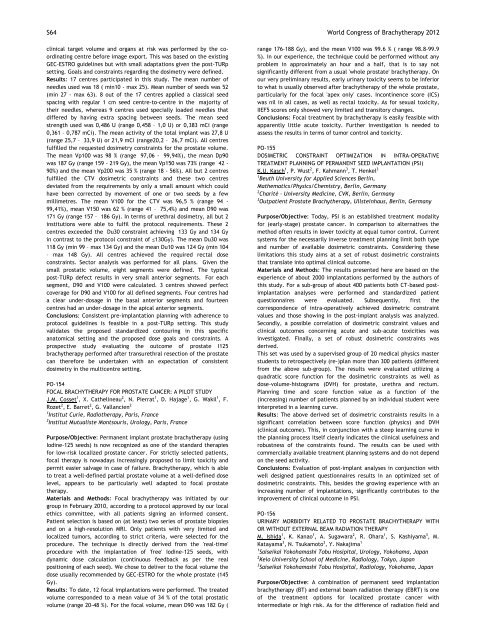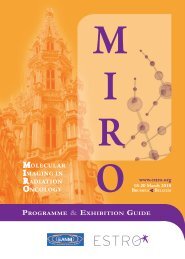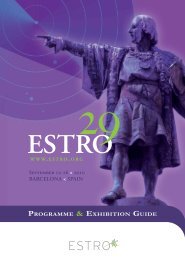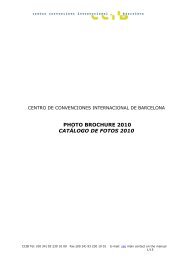World Congress of Brachytherapy 10-12 May, 2012 - Estro-events.org
World Congress of Brachytherapy 10-12 May, 2012 - Estro-events.org
World Congress of Brachytherapy 10-12 May, 2012 - Estro-events.org
You also want an ePaper? Increase the reach of your titles
YUMPU automatically turns print PDFs into web optimized ePapers that Google loves.
S64 <strong>World</strong> <strong>Congress</strong> <strong>of</strong> <strong>Brachytherapy</strong> 20<strong>12</strong><br />
clinical target volume and <strong>org</strong>ans at risk was performed by the co<br />
ordinating centre before image export. This was based on the existing<br />
GECESTRO guidelines but with small adaptations given the postTURp<br />
setting. Goals and constraints regarding the dosimetry were defined.<br />
: 17 centres participated in this study. The mean number <strong>of</strong><br />
needles used was 18 ( min<strong>10</strong> max 25). Mean number <strong>of</strong> seeds was 52<br />
(min 27 max 63). 8 out <strong>of</strong> the 17 centres applied a classical seed<br />
spacing with regular 1 cm seed centretocentre in the majority <strong>of</strong><br />
their needles, whereas 9 centres used specially loaded needles that<br />
differed by having extra spacing between seeds. The mean seed<br />
strength used was 0,486 U (range 0,458 – 1,0 U) or 0,383 mCi (range<br />
0,361 – 0,787 mCi). The mean activity <strong>of</strong> the total implant was 27,8 U<br />
(range 25,7 – 33,9 U) or 21,9 mCi (range20,2 – 26,7 mCi). All centres<br />
fulfilled the requested dosimetry constraints for the prostate volume.<br />
The mean Vp<strong>10</strong>0 was 98 % (range 97,06 99,94%), the mean Dp90<br />
was 187 Gy (range 159 219 Gy), the mean Vp150 was 73% (range 42 <br />
90%) and the mean Vp200 was 35 % (range 18 56%). All but 2 centres<br />
fulfilled the CTV dosimetric constraints and these two centres<br />
deviated from the requirements by only a small amount which could<br />
have been corrected by movement <strong>of</strong> one or two seeds by a few<br />
millimetres. The mean V<strong>10</strong>0 for the CTV was 96,5 % (range 94 <br />
99,41%), mean V150 was 62 % (range 41 – 75,4%) and mean D90 was<br />
171 Gy (range 157 – 186 Gy). In terms <strong>of</strong> urethral dosimetry, all but 2<br />
institutions were able to fulfil the protocol requirements. These 2<br />
centres exceeded the Du30 constraint achieving 133 Gy and 134 Gy<br />
in contrast to the protocol constraint <strong>of</strong> ≤130Gy). The mean Du30 was<br />
118 Gy (min 99 – max 134 Gy) and the mean Du<strong>10</strong> was <strong>12</strong>4 Gy (min <strong>10</strong>4<br />
– max 148 Gy). All centres achieved the required rectal dose<br />
constraints. Sector analysis was performed for all plans. Given the<br />
small prostatic volume, eight segments were defined. The typical<br />
postTURp defect results in very small anterior segments. For each<br />
segment, D90 and V<strong>10</strong>0 were calculated. 3 centres showed perfect<br />
coverage for D90 and V<strong>10</strong>0 for all defined segments. Four centres had<br />
a clear underdosage in the basal anterior segments and fourteen<br />
centres had an underdosage in the apical anterior segments.<br />
: Consistent preimplantation planning with adherence to<br />
protocol guidelines is feasible in a postTURp setting. This study<br />
validates the proposed standardized contouring in this specific<br />
anatomical setting and the proposed dose goals and constraints. A<br />
prospective study evaluating the outcome <strong>of</strong> prostate I<strong>12</strong>5<br />
brachytherapy performed after transurethral resection <strong>of</strong> the prostate<br />
can therefore be undertaken with an expectation <strong>of</strong> consistent<br />
dosimetry in the multicentre setting.<br />
PO154<br />
FOCAL BRACHYTHERAPY FOR PROSTATE CANCER: A PILOT STUDY<br />
J.M. Cosset 1 , X. Cathelineau 2 , N. Pierrat 1 , D. Hajage 1 , G. Wakil 1 , F.<br />
Rozet 2 , E. Barret 2 , G. Vallancien 2<br />
1 Institut Curie, Radiotherapy, Paris, France<br />
2 Institut Mutualiste Montsouris, Urology, Paris, France<br />
: Permanent implant prostate brachytherapy (using<br />
Iodine<strong>12</strong>5 seeds) is now recognized as one <strong>of</strong> the standard therapies<br />
for lowrisk localized prostate cancer. For strictly selected patients,<br />
focal therapy is nowadays increasingly proposed to limit toxicity and<br />
permit easier salvage in case <strong>of</strong> failure. <strong>Brachytherapy</strong>, which is able<br />
to treat a welldefined partial prostate volume at a welldefined dose<br />
level, appears to be particularly well adapted to focal prostate<br />
therapy.<br />
: Focal brachytherapy was initiated by our<br />
group in February 20<strong>10</strong>, according to a protocol approved by our local<br />
ethics committee, with all patients signing an informed consent.<br />
Patient selection is based on (at least) two series <strong>of</strong> prostate biopsies<br />
and on a highresolution MRI. Only patients with very limited and<br />
localized tumors, according to strict criteria, were selected for the<br />
procedure. The technique is directly derived from the 'realtime'<br />
procedure with the implantation <strong>of</strong> 'free' Iodine<strong>12</strong>5 seeds, with<br />
dynamic dose calculation (continuous feedback as per the real<br />
positioning <strong>of</strong> each seed). We chose to deliver to the focal volume the<br />
dose usually recommended by GECESTRO for the whole prostate (145<br />
Gy).<br />
: To date, <strong>12</strong> focal implantations were performed. The treated<br />
volume corresponded to a mean value <strong>of</strong> 34 % <strong>of</strong> the total prostatic<br />
volume (range 2048 %). For the focal volume, mean D90 was 182 Gy (<br />
range 176188 Gy), and the mean V<strong>10</strong>0 was 99.6 % ( range 98.899.9<br />
%). In our experience, the technique could be performed without any<br />
problem in approximately an hour and a half, that is to say not<br />
significantly different from a usual 'whole prostate' brachytherapy. On<br />
our very preliminary results, early urinary toxicity seems to be inferior<br />
to what is usually observed after brachytherapy <strong>of</strong> the whole prostate,<br />
particularly for the focal 'apex only' cases. Incontinence score (ICS)<br />
was nil in all cases, as well as rectal toxicity. As for sexual toxicity,<br />
IIEF5 scores only showed very limited and transitory changes.<br />
: Focal treatment by brachytherapy is easily feasible with<br />
apparently little acute toxicity. Further investigation is needed to<br />
assess the results in terms <strong>of</strong> tumor control and toxicity.<br />
PO155<br />
DOSIMETRIC CONSTRAINT OPTIMIZATION IN INTRAOPERATIVE<br />
TREATMENT PLANNING OF PERMANENT SEED IMPLANTATION (PSI)<br />
K.U. Kasch 1 , P. Wust 2 , F. Kahmann 3 , T. Henkel 3<br />
1<br />
Beuth University for Applied Sciences Berlin,<br />
Mathematics/Physics/Chemistry, Berlin, Germany<br />
2<br />
Charité – University Medicine, CVK, Berlin, Germany<br />
3<br />
Outpatient Prostate <strong>Brachytherapy</strong>, Ullsteinhaus, Berlin, Germany<br />
: Today, PSI is an established treatment modality<br />
for (earlystage) prostate cancer. In comparison to alternatives the<br />
method <strong>of</strong>ten results in lower toxicity at equal tumor control. Current<br />
systems for the necessarily inverse treatment planning limit both type<br />
and number <strong>of</strong> available dosimetric constraints. Considering these<br />
limitations this study aims at a set <strong>of</strong> robust dosimetric constraints<br />
that translate into optimal clinical outcome.<br />
: The results presented here are based on the<br />
experience <strong>of</strong> about 2000 implantations performed by the authors <strong>of</strong><br />
this study. For a subgroup <strong>of</strong> about 400 patients both CTbased post<br />
implantation analyses were performed and standardized patient<br />
questionnaires were evaluated. Subsequently, first the<br />
correspondence <strong>of</strong> intraoperatively achieved dosimetric constraint<br />
values and those showing in the postimplant analysis was analyzed.<br />
Secondly, a possible correlation <strong>of</strong> dosimetric constraint values and<br />
clinical outcomes concerning acute and subacute toxicities was<br />
investigated. Finally, a set <strong>of</strong> robust dosimetric constraints was<br />
derived.<br />
This set was used by a supervised group <strong>of</strong> 20 medical physics master<br />
students to retrospectively (re)plan more than 300 patients (different<br />
from the above subgroup). The results were evaluated utilizing a<br />
quadratic score function for the dosimetric constraints as well as<br />
dosevolumehistograms (DVH) for prostate, urethra and rectum.<br />
Planning time and score function value as a function <strong>of</strong> the<br />
(increasing) number <strong>of</strong> patients planned by an individual student were<br />
interpreted in a learning curve.<br />
: The above derived set <strong>of</strong> dosimetric constraints results in a<br />
significant correlation between score function (physics) and DVH<br />
(clinical outcome). This, in conjunction with a steep learning curve in<br />
the planning process itself clearly indicates the clinical usefulness and<br />
robustness <strong>of</strong> the constraints found. The results can be used with<br />
commercially available treatment planning systems and do not depend<br />
on the seed activity.<br />
: Evaluation <strong>of</strong> postimplant analyses in conjunction with<br />
well designed patient questionnaires results in an optimized set <strong>of</strong><br />
dosimetric constraints. This, besides the growing experience with an<br />
increasing number <strong>of</strong> implantations, significantly contributes to the<br />
improvement <strong>of</strong> clinical outcome in PSI.<br />
PO156<br />
URINARY MORBIDITY RELATED TO PROSTATE BRACHYTHERAPY WITH<br />
OR WITHOUT EXTERNAL BEAM RADIATION THERAPY<br />
M. Ishida 1 , K. Kanao 1 , A. Sugawara 2 , R. Ohara 1 , S. Kashiyama 3 , M.<br />
Katayama 3 , N. Tsukamoto 3 , Y. Nakajima 1<br />
1 Saiseikai Yokohamashi Tobu Hosipital, Urology, Yokohama, Japan<br />
2 Keio University School <strong>of</strong> Medicine, Radiology, Tokyo, Japan<br />
3 Saiseikai Yokohamashi Tobu Hosipital, Radiology, Yokohama, Japan<br />
: A combination <strong>of</strong> permanent seed implantation<br />
brachytherapy (BT) and external beam radiation therapy (EBRT) is one<br />
<strong>of</strong> the treatment options for localized prostate cancer with<br />
intermediate or high risk. As for the difference <strong>of</strong> radiation field and<br />
<strong>World</strong> <strong>Congress</strong> <strong>of</strong> <strong>Brachytherapy</strong> 20<strong>12</strong> S 65<br />
radiation dose between the cases treated with BT alone or BT<br />
combined with EBRT (BT + EBRT), the divergence <strong>of</strong> posttreatment<br />
urinary morbidity may be seen. This study is to clarify the difference<br />
<strong>of</strong> urinary morbidity in the cases treated with BT alone or BT + EBRT.<br />
: Seventyseven histologically confirmed<br />
prostate adenocarcinoma patients underwent iodine<strong>12</strong>5 seed BT in<br />
our institute between October 2009 and June 2011. Among those<br />
patients, <strong>10</strong> with incomplete data were excluded from this study. The<br />
median age was 72, ranged from 45 to 81. Of those 67 patients<br />
included in this study, 43 (64.2%) were treated with BT alone with<br />
prescription dose <strong>of</strong> 160 Gy and the other 24, who were evaluated as<br />
intermediate or high risk under D’Amico classification, were treated<br />
with 1<strong>10</strong> Gy <strong>of</strong> BT followed by 45 Gy (1.8 Gy x 25) <strong>of</strong> EBRT.<br />
International Prostate Symptom Score (IPSS) was obtained from those<br />
67 patients before BT (baseline) and 3 months (3M) after BT or BT +<br />
EBRT to evaluate voiding condition. To characterize urinary morbidity<br />
related to BT, changes <strong>of</strong> the scores from the baseline and the<br />
difference <strong>of</strong> the scores between two treatment groups were<br />
statistically analyzed with MannWhitney Utest.<br />
: Prostate volume was same in both treatment groups (BT<br />
alone: 26.7 ± 6.5 cc, BT+EBRT: 25.2 ± 11.8 cc, p = 0.16). There was<br />
no significant difference in total Biochemical Effective Dose (BED)<br />
between two groups, but BED <strong>of</strong> brachytherapy was higher in BT alone<br />
group (BT alone: 216.2 ± 25.1 Gy, BT+EBRT: 137.4 ± 17.7 Gy, p <<br />
0.01). There were no significant differences in total IPSS and<br />
obstructive urinary symptom score between the two treatment groups<br />
at baseline, however, irritative urinary symptom score was higher in<br />
BT+EBRT group (BT alone: 4.8 ± 2.8, BT+EBRT: 6.3 ± 3.2, p < 0.05).<br />
The changes <strong>of</strong> total IPSS from baseline revealed difference between<br />
the two treatment groups (BT alone: 8.7 ± 6.4, BT+EBRT: 0.6 ± 5.3, p<br />
< 0.01) showing that BT+EBRT had better voiding condition. The<br />
changes <strong>of</strong> obstructive urinary symptom score between the two<br />
treatment groups showed significant difference (BT alone: 5.6 ± 3.9,<br />
BT+EBRT 0.2 ± 3.3, p < 0.01). There was a significant difference<br />
between the two treatment groups on the changes <strong>of</strong> irritative urinary<br />
symptom score (BT alone: 3.0 ± 3.2, BT+EBRT 0.8 ± 2.8, p < 0.01).<br />
Urinary retention was not observed in both treatment groups.<br />
: According to the results <strong>of</strong> this study, urinary morbidity<br />
during the first 3 months after BT was lower in cases treated with BT<br />
combined with EBRT compared with cases treated with BT alone. It<br />
suggests that urinary morbidity is rather related to the radiation dose<br />
<strong>of</strong> implanted seeds than total BED.<br />
PO157<br />
RECTAL BALLOONS AND THE RISK OF SECONDARY RECTAL CANCER<br />
AFTER COMBINED MODALITY PROSTATE RADIATION<br />
R.J. Burri 1 , J. Ng 2 , D.P. Horowitz 2 , J.A. Cesaretti 3 , M. Terk 4 , J. Kao 5 ,<br />
T. Stephens 5 , K.S.C. Chao 2 , D.J. Brenner 6 , I. Shuryak 6<br />
1<br />
Tampa Bay Cancer Center, Radiation Oncology, Sun City Center FL,<br />
USA<br />
2<br />
Columbia University Medical Center, Radiation Oncology, New York<br />
NY, USA<br />
3<br />
Tampa Bay Cancer Center, Radiation Oncology, Tampa FL, USA<br />
4<br />
Florida Radiation Oncology Group, Radiation Oncology, Jacksonville<br />
FL, USA<br />
5<br />
Tampa Bay Cancer Center, Radiation Oncology, Brandon FL, USA<br />
6<br />
Columbia University Medical Center, Center for Radiological<br />
Research, New York NY, USA<br />
: An increased risk <strong>of</strong> secondary rectal malignancy<br />
is an established problem following definitive external beam radiation<br />
therapy (EBRT) for prostate cancer. Many highrisk, and some<br />
intermediaterisk, patients are currently treated with combined<br />
brachytherapy and EBRT, usually with an intensitymodulated<br />
radiation therapy (IMRT) plan to 45 Gy. In this study, a biologically<br />
based carcinogenesis model was used to quantitate and compare the<br />
predicted risk <strong>of</strong> secondary rectal cancer in men treated with or<br />
without a rectal balloon in place during the IMRT portion <strong>of</strong> combined<br />
modality therapy.<br />
: Treatment plans were developed for ten<br />
clinically localized prostate cancer patients using CT scans obtained<br />
both with and without a rectal balloon in place. Target volumes<br />
(prostate and proximal 1.5 cm <strong>of</strong> seminal vesicles) and normal<br />
structures were contoured, and dosevolume histograms (DVHs) for<br />
these <strong>org</strong>ans were determined with a planned IMRT dose <strong>of</strong> 45 Gy. A<br />
biologicallybased mathematical model <strong>of</strong> spontaneous and radiation<br />
induced carcinogenesis was used to determine the excess absolute risk<br />
<strong>of</strong> secondary rectal malignancies both with and without the rectal<br />
balloon in place. These risks were then compared to one another and<br />
to the baseline population.<br />
: Treatment with a rectal balloon in place resulted in a<br />
significantly lower mean rectal wall dose in all patients compared<br />
with treatment without a rectal balloon. The average mean rectal<br />
wall dose with a rectal balloon in place was 17.2 Gy versus 20.7 Gy<br />
without the rectal balloon (p=0.001). A significantly higher risk <strong>of</strong><br />
secondary rectal cancers was predicted for patients treated without<br />
rectal balloons when compared with patients treated with balloons in<br />
place (p=0.001, relative risk 1.22; 95% confidence interval 1.<strong>10</strong>1.34).<br />
: For prostate cancer patients treated with combined<br />
brachytherapy and external beam radiation therapy, the use <strong>of</strong> a<br />
rectal balloon during the IMRT portion <strong>of</strong> treatment is associated with<br />
a significant reduction in the predicted risk <strong>of</strong> secondary rectal<br />
malignancy.<br />
PO158<br />
PHASE II TRIAL OF HIGHDOSE RATE BRACHYTHERAPY AND EXTERNAL<br />
RADIATION FOR INTERMEDIATERISK PROSTATE CANCER<br />
I. Tsukiyama 1 , R. Kobayashi 1 , J. Hiratsuka 2 , S. Kariya 3 , S. Uehara 4 , T.<br />
Dokiya 5 , H. Sekine 6 , T. Sato 7<br />
1<br />
Aidu Central Hospital, Radiology, Fukushima, Japan<br />
2<br />
Kawasaki Medical College, Radiation Oncology, Kurashiki, Japan<br />
3<br />
Kochi University, Diagnostic Radiology and Radiation Oncology,<br />
Kochi, Japan<br />
4<br />
Kyushu Cancer Center, Radiology, Fukuoka, Japan<br />
5<br />
Saitama Medical University, Radiation Oncology, Hidaka, Japan<br />
6<br />
Jikei University School <strong>of</strong> Medicine, Radiation Oncology, Tokyo,<br />
Japan<br />
7<br />
Kitasato University, Urology, Kanagawa, Japan<br />
: To estimate the rate <strong>of</strong> early and late Grade 3 or<br />
greater genitourinary and gastrointestinal adverse <strong>events</strong> after<br />
treatment with external beam radiotherapy and prostate highdose<br />
rate (HDR) brachytherapy.<br />
: Patients with locally confined T2b,T2c or<br />
<strong>10</strong>ng/ml < PSA ≤ 20ng/ml or Gleason score=7 prostate cancer were<br />
eligible for the present study. All patients were treated 39 Gy in 13<br />
fractions using external beam radiotherapy and one HDR implant<br />
delivering 18 Gy in two fractions. All adverse event were graded<br />
according to the Common Terminology Criteria for Adverse Event,<br />
version 3.0. Early adverse <strong>events</strong> were those occurring less than 9<br />
months and late adverse <strong>events</strong> were those occurring more than <strong>12</strong><br />
months from the start <strong>of</strong> the protocol treatment. Primary endpoint <strong>of</strong><br />
this study is rate <strong>of</strong> late Grade 3 or later adverse event. Secondary<br />
endpoints are rate <strong>of</strong> early Grade 3 adverse event and PSA failure<br />
rate.<br />
: A total <strong>of</strong> 92 patients from 5 institutions were enrolled in the<br />
present study. Of the 92 patients, 84 were eligible. Each rate <strong>of</strong> early<br />
adverse <strong>events</strong> <strong>of</strong> Grade 1 after three, six and nine months from the<br />
irradiation was 63%, 70% and 37% respectively, and that <strong>of</strong> Grade 2<br />
was 9%, 5%, and 3% respectively. Each rate <strong>of</strong> late adverse <strong>events</strong> <strong>of</strong><br />
Grade 1 after <strong>12</strong>, 18 and 24 months from the irradiation was 28%, 73%<br />
and 0% respectively, and that <strong>of</strong> Grade 2 was 4%, 0%, and 0%<br />
respectively. No adverse <strong>events</strong> <strong>of</strong> Grade 3 or greater were observed.<br />
Among 84 cases, only one patient caused PSA failure. The patient was<br />
treated with endocrine therapy.<br />
: As a result <strong>of</strong> highdose rate brachytherapy combined<br />
with external irradiation for intermediaterisk prostatic cancer, early<br />
and late adverse <strong>events</strong> <strong>of</strong> Grade 3 or greater did not occur, and only<br />
one patient had biochemical failure among the 84 patient. The<br />
technique and doses used in the present study resulted in acceptable<br />
level <strong>of</strong> adverse <strong>events</strong>.<br />
PO159<br />
LONG TERM TOXICITY FOLLOWING CS131 PROSTATE BRACHYTHERAPY<br />
R.P. Smith 1 , S. Beriwal 1 , R.M. Benoit 2<br />
1<br />
University <strong>of</strong> Pittsburgh, Radiation Oncology, Pittsburgh, USA<br />
2<br />
University <strong>of</strong> Pittsburgh, Urology, Pittsburgh, USA









